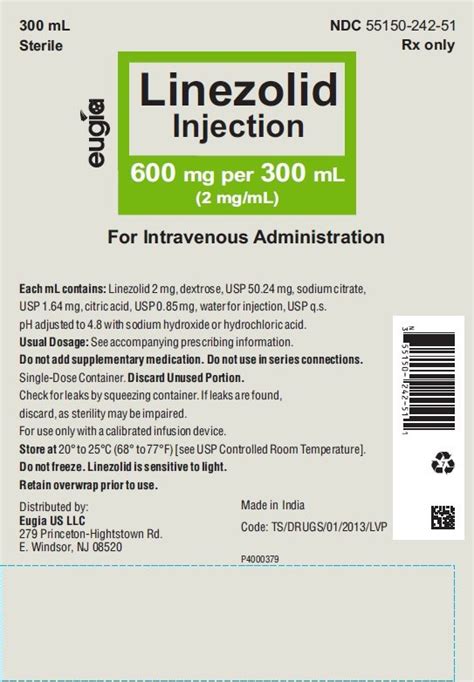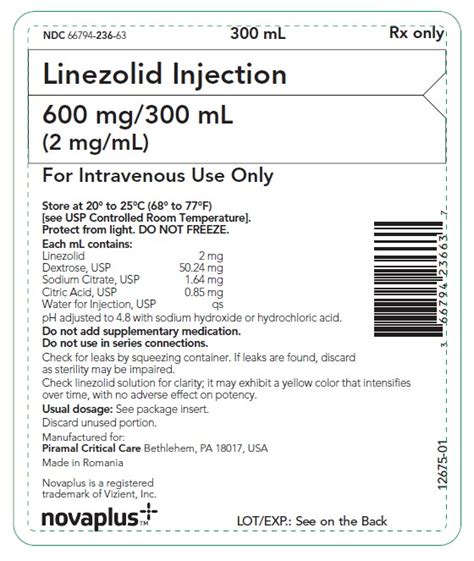Intro
Discover Linezolid side effects, including antibiotic resistance, thrombocytopenia, and neuropathy. Learn about interactions, warnings, and precautions to minimize risks and ensure safe treatment with this oxazolidinone antibiotic.
The importance of understanding the side effects of medications cannot be overstated, especially when it comes to antibiotics like linezolid. Linezolid is an antibiotic used to treat various bacterial infections, including pneumonia, skin infections, and infections caused by resistant strains of bacteria. While it is effective in treating these conditions, linezolid can cause a range of side effects, some of which can be serious. In this article, we will delve into the world of linezolid side effects, exploring what they are, how they occur, and what you can do to manage them.
Linezolid is a member of the oxazolidinone class of antibiotics, which work by inhibiting the production of proteins in bacteria, ultimately leading to their death. While this mechanism of action is effective in treating bacterial infections, it can also affect the body in various ways, leading to side effects. Some of the most common side effects of linezolid include nausea, vomiting, diarrhea, and headache. These side effects are usually mild and temporary, but in some cases, they can be severe and require medical attention.
The severity and frequency of linezolid side effects can vary depending on several factors, including the dose and duration of treatment, as well as the individual's overall health and medical history. For example, people with a history of liver or kidney disease may be more susceptible to certain side effects, such as increased liver enzymes or kidney damage. It is essential to discuss your medical history and any concerns you may have with your doctor before starting treatment with linezolid.
Common Side Effects of Linezolid

Linezolid can cause a range of common side effects, including gastrointestinal symptoms, such as nausea, vomiting, and diarrhea. These side effects are usually mild and temporary, but in some cases, they can be severe and require medical attention. Other common side effects of linezolid include headache, dizziness, and fatigue. These side effects can be uncomfortable, but they are usually not serious and can be managed with rest, hydration, and over-the-counter medications.
Some of the common side effects of linezolid include:
- Nausea and vomiting
- Diarrhea
- Headache
- Dizziness
- Fatigue
- Insomnia
- Constipation
- Abdominal pain
Less Common Side Effects of Linezolid

While the common side effects of linezolid are usually mild and temporary, there are some less common side effects that can be more serious. These side effects can include increased liver enzymes, kidney damage, and blood disorders, such as anemia and thrombocytopenia. These side effects are usually rare, but they can be severe and require medical attention.
Some of the less common side effects of linezolid include:
- Increased liver enzymes
- Kidney damage
- Anemia
- Thrombocytopenia
- Neutropenia
- Seizures
- Hypertension
- Hypotension
Severe Side Effects of Linezolid

While the common and less common side effects of linezolid are usually manageable, there are some severe side effects that can be life-threatening. These side effects can include serotonin syndrome, a condition caused by excessive levels of serotonin in the body, and lactic acidosis, a condition caused by the buildup of lactic acid in the body. These side effects are usually rare, but they can be severe and require immediate medical attention.
Some of the severe side effects of linezolid include:
- Serotonin syndrome
- Lactic acidosis
- Stevens-Johnson syndrome
- Toxic epidermal necrolysis
- Anaphylaxis
- Angioedema
Managing Linezolid Side Effects

While the side effects of linezolid can be uncomfortable and, in some cases, severe, there are several ways to manage them. For example, if you experience nausea and vomiting, you can try taking anti-nausea medications or eating small, frequent meals. If you experience diarrhea, you can try taking anti-diarrheal medications or increasing your fluid intake.
Some tips for managing linezolid side effects include:
- Taking linezolid with food to reduce gastrointestinal side effects
- Increasing fluid intake to prevent dehydration
- Getting plenty of rest to reduce fatigue
- Avoiding strenuous activities to reduce dizziness and lightheadedness
- Monitoring your blood sugar levels if you have diabetes
Linezolid Interactions

Linezolid can interact with several medications, including antidepressants, such as selective serotonin reuptake inhibitors (SSRIs), and blood thinners, such as warfarin. These interactions can increase the risk of side effects, such as serotonin syndrome and bleeding.
Some medications that can interact with linezolid include:
- SSRIs, such as fluoxetine and sertraline
- Monoamine oxidase inhibitors (MAOIs), such as phenelzine and tranylcypromine
- Blood thinners, such as warfarin and aspirin
- Medications that increase the risk of bleeding, such as ibuprofen and naproxen
Linezolid Warnings and Precautions

Linezolid can cause several warnings and precautions, including the risk of serotonin syndrome, lactic acidosis, and seizures. It can also increase the risk of bleeding and interact with several medications.
Some warnings and precautions to be aware of when taking linezolid include:
- The risk of serotonin syndrome, especially when taken with SSRIs or MAOIs
- The risk of lactic acidosis, especially in people with liver or kidney disease
- The risk of seizures, especially in people with a history of seizure disorders
- The risk of bleeding, especially when taken with blood thinners or medications that increase the risk of bleeding
Conclusion and Final Thoughts

In conclusion, linezolid is an effective antibiotic for treating various bacterial infections, but it can cause a range of side effects, some of which can be severe. It is essential to discuss your medical history and any concerns you may have with your doctor before starting treatment with linezolid. By understanding the potential side effects and taking steps to manage them, you can minimize the risks associated with linezolid and maximize its benefits.
We hope this article has provided you with a comprehensive understanding of linezolid side effects and how to manage them. If you have any questions or concerns, please do not hesitate to comment below. We also invite you to share this article with anyone who may be taking linezolid or considering treatment with this antibiotic.
What are the most common side effects of linezolid?
+The most common side effects of linezolid include nausea, vomiting, diarrhea, and headache. These side effects are usually mild and temporary, but in some cases, they can be severe and require medical attention.
Can linezolid cause serious side effects?
+Yes, linezolid can cause serious side effects, including serotonin syndrome, lactic acidosis, and seizures. These side effects are usually rare, but they can be severe and require immediate medical attention.
How can I manage linezolid side effects?
+You can manage linezolid side effects by taking the medication with food, increasing your fluid intake, getting plenty of rest, and avoiding strenuous activities. You should also monitor your blood sugar levels if you have diabetes and report any severe side effects to your doctor immediately.
